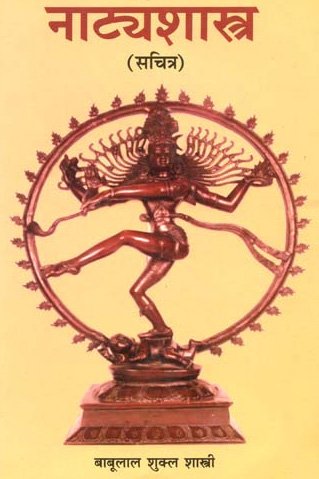Bhrantimat, Bhrāntimat, Bhrāntimān, Bhrantiman: 6 definitions
Introduction:
Bhrantimat means something in Hinduism, Sanskrit. If you want to know the exact meaning, history, etymology or English translation of this term then check out the descriptions on this page. Add your comment or reference to a book if you want to contribute to this summary article.
In Hinduism
Natyashastra (theatrics and dramaturgy)
Source: Shodhganga: Mankhaka a sanskrit literary genius (natya)Bhrāntimān (भ्रान्तिमान्, “error”) refers to a type of Alaṃkāra (figure of speech).—Bhrāntimān or error is the apprehension, from resemblance, of an object as being what it is not, if it is suggested by poetical imagination.

Natyashastra (नाट्यशास्त्र, nāṭyaśāstra) refers to both the ancient Indian tradition (shastra) of performing arts, (natya—theatrics, drama, dance, music), as well as the name of a Sanskrit work dealing with these subjects. It also teaches the rules for composing Dramatic plays (nataka), construction and performance of Theater, and Poetic works (kavya).
Kavyashastra (science of poetry)
Source: Shodhganga: The Kavyavilasa of Ciranjiva Bhattacarya (kavyashastra)Bhrāntimān (भ्रान्तिमान्) is another name for Bhrānti: one of the 93 alaṃkāras (“figures of speech”) mentioned by Cirañjīva Bhaṭṭācārya (fl. 17th century) in his Kāvyavilāsa and is listed as one of the 89 arthālaṃkāras (figure of speech determined by the sense, as opposed to sound).—Cirañjīva has treated the figure named bhrānti. The predecessors of Cirañjīva like Mammaṭa Ruyyaka Viśvanātha and Jagannātha have given the name bhrāntimān instead of bhrānti. Infact bhrāntimān and bhrānti these two are same in nature. Whenever a thing is perceived or taken as another thing due to similarity it is called bhrānti or illusion.

Kavyashastra (काव्यशास्त्र, kāvyaśāstra) refers to the ancient Indian tradition of poetry (kavya). Canonical literature (shastra) of the includes encyclopedic manuals dealing with prosody, rhetoric and various other guidelines serving to teach the poet how to compose literature.
Languages of India and abroad
Sanskrit dictionary
Source: DDSA: The practical Sanskrit-English dictionaryBhrāntimat (भ्रान्तिमत्).—a.
1) Revolving, turning round; भ्रान्तिमद्वारियन्त्रम् (bhrāntimadvāriyantram) M.2.18.
2) Erring, mistaking, being under a delusion. -m. A figure of speech in which one thing is represented as being mistaken for another an account of the close resemblance between the two; भान्तिमानन्य- संवित्तत्तुल्यदर्शने (bhāntimānanya- saṃvittattulyadarśane) K. P.1; e. g. कपाले मार्जारः पय इति करान् लेढि शशिनः (kapāle mārjāraḥ paya iti karān leḍhi śaśinaḥ) &c.; see V.3.2; Mālatīmādhava (Bombay) 1.2 also.
Source: Cologne Digital Sanskrit Dictionaries: Shabda-Sagara Sanskrit-English DictionaryBhrāntimat (भ्रान्तिमत्).—mfn. (-mān-matī-mat) 1. Erring, mistaking. 2. Wandering. m. (-mān) A figure of speech (in rhetoric.) E. bhrānti, and matup aff.
Source: Cologne Digital Sanskrit Dictionaries: Monier-Williams Sanskrit-English Dictionary1) Bhrāntimat (भ्रान्तिमत्):—[=bhrānti-mat] [from bhrānti > bhram] mfn. roaming or wandering about, [Bālarāmāyaṇa]
2) [v.s. ...] turning round, rolling (as a wheel), [Mālavikāgnimitra]
3) [v.s. ...] mistaking any one or anything for ([compound]), [Prāyaścitta-tattva]
4) [v.s. ...] a [particular] figure of rhetoric (describing an error), [Kāvyaprakāśa]
Source: Cologne Digital Sanskrit Dictionaries: Yates Sanskrit-English DictionaryBhrāntimat (भ्रान्तिमत्):—[(mān-matī-mat) a.] Erring.
Sanskrit, also spelled संस्कृतम् (saṃskṛtam), is an ancient language of India commonly seen as the grandmother of the Indo-European language family (even English!). Closely allied with Prakrit and Pali, Sanskrit is more exhaustive in both grammar and terms and has the most extensive collection of literature in the world, greatly surpassing its sister-languages Greek and Latin.
See also (Relevant definitions)
Partial matches: Mat, Bhranti.
Full-text: Bhranti, Vacyalankara.
Relevant text
Search found 5 books and stories containing Bhrantimat, Bhranti-mat, Bhrāntimat, Bhrāntimān, Bhrantiman, Bhrānti-mat; (plurals include: Bhrantimats, mats, Bhrāntimats, Bhrāntimāns, Bhrantimans). You can also click to the full overview containing English textual excerpts. Below are direct links for the most relevant articles:
Sahitya-kaumudi by Baladeva Vidyabhushana (by Gaurapada Dāsa)
Text 10.221 [Bhrāntimān] < [Chapter 10 - Ornaments of Meaning]
Text 10.248 < [Chapter 10 - Ornaments of Meaning]
Text 10.222 < [Chapter 10 - Ornaments of Meaning]
The backdrop of the Srikanthacarita and the Mankhakosa (by Dhrubajit Sarma)
Part 5n - Alaṃkāra (14): Bhrāntimān or error < [Chapter III - Literary Assessment Of The Śrīkaṇṭhacarita]
Mudrarakshasa (literary study) (by Antara Chakravarty)
3.4a. Arthālaṃkāras (Alaṃkāras that depend upon the meanings of words) < [Chapter 3 - Use of Alaṃkāras in Mudrārākṣasa]
Alamkaras mentioned by Vamana (by Pratim Bhattacharya)
3: The classification of poetic figures < [Chapter 5 - A Comparative study of the different alaṃkāras mentioned by Vāmana]
1-2: The number of Alaṃkāras (poetic figures) mentioned < [Chapter 5 - A Comparative study of the different alaṃkāras mentioned by Vāmana]
6: Definition of Rūpaka Alaṃkāra < [Chapter 4 - Arthālaṃkāras mentioned by Vāmana]
Shishupala-vadha (Study) (by Shila Chakraborty)
Knowledge of Rhetoric (Alaṃkāra) in the Śiśupālavadha < [Introduction]